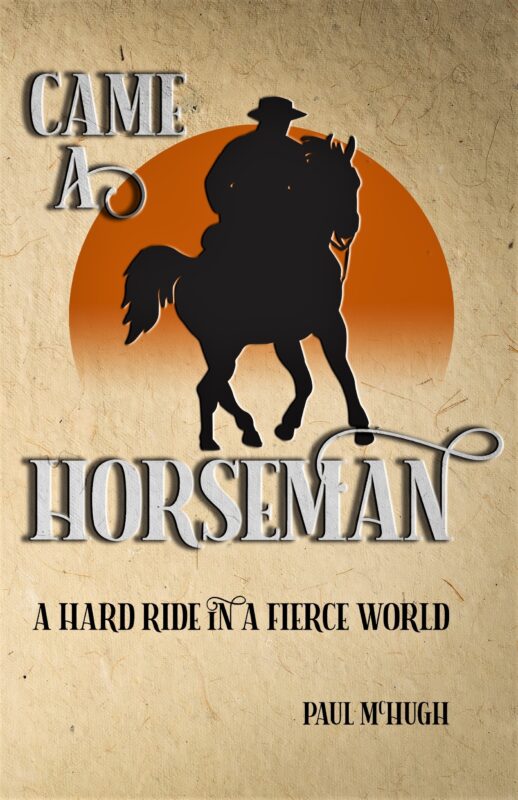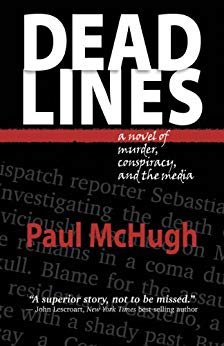California North Coast Series: A Kayak Adventure
Paul McHugh, Outdoors Writer
September 10
The gale blew itself out by midnight Friday, though we could still hear rain spatter on the roof of the steel building on Whaler Island where we’d taken refuge. Both the National Oceanic and Atmospheric Administration weather radio and www.weatherunderground.com, Bo Barnes’ favorite Web site, forecast falling winds and a reduced swell for Saturday.
So we rose at 5:30 a.m., gobbled a simple breakfast, then packed our boats under patchy fog and a light drizzle.
For the first time, I elected to wear my surfer’s full wetsuit as the day’s paddling garment for its extra warmth. Seven hours later, as we crashed across the Klamath River bar, I would be mighty glad I’d worn it.

The paddlers take a measure of gale-force winds on the jetty at Crescent City. Photo by Michael Maloney, S. F. Chronicle.
A few miles south of Crescent City, we cruised past Nickel Creek. Then began the wildest stretch of shore imaginable: steep ramparts, with soaring, sea-washed monoliths, crowned by a dark green band of primal forest and wreathed with mist.
“That coast looks just as it did a thousand years ago,” I told John Weed. “Or two thousand years. Just about forever, anyhow.”
Weed nodded and grinned. “It’s what I love,” he said.
Our course of 150 degrees lined us up with The Sisters, a pair of massive sea stacks (offshore rocks), then the distant, fogbound Requa Overlook at the mouth of the Klamath River. So I didn’t even bother to switch on the GPS, just held to my bearing on the deck compass as those big rocks played hide and seek through banks of drifting sea mist.
Aftermath of Gale Winds
One thing worried me. The groundswell, thickened and invigorated by Friday’s gale winds, still coursed under our hulls to explode against those steep coastal bluffs. If it didn’t subside by time we made landfall, we could be in for a beating.
The Sisters drew steadily closer. But it sure didn’t seem that way.
“Those rocks have been only half an hour away from us for about two hours now,” Weed observed.
That’s the way it is with sea kayak voyages. If patience is a virtue, long-distance paddling must be its top school.
In the lee of the seaward Sister, we found a slick patch of water, sheltered from both the swell and wind chop, so I suggested we pause for snacks and raft up (lay the kayaks side-by-side for enhanced stability — a trick used since the heyday of the ancient Aleut paddlers, sometimes even to pass an entire night at sea).
After we resumed travel southward, Barnes felt moved to glance over his shoulder and saw a 7-foot wall of foam tumble through a rocky slot near where we had lunched. It was a warning shot across our sterns. That swell was not diminishing. We guessed it to be staying in the 9- to 10-foot range.
More beautiful stretches of wild shore slid by to port. But they commanded less and less attention. I can’t speak for the others, but my brain grew quite busy concocting scenarios for our landing at the Klamath River bar, and coming up with reminders about techniques for maneuvering in harsh surf.
False Klamath Cove
At False Klamath Cove — where Jedediah Smith’s expedition had first reached the Pacific Ocean in 1828, I swung in to scout a possible emergency landing site at the Wilson Creek bridge. That site looked tough, but do-able. With it as a bail-out option, we continued on course, around the final headland to the Klamath.
Long “V’s” of brown pelicans soared overhead, winging north. But they did not descend to glide in the troughs of the waves as they usually do — perhaps they did not like these wind-roughened big lumps any more than we.
We passed huge sea caves, marked by arched bands of purple rock, much like the Highway 101 tunnel into Marin County. Then there was an immense cliff, also faced with purple. We turned the corner, and sighted Oregos (Orr-RAY-gahs), the signature rock, sacred to the Yurok tribe, that stands sentinel at the mouth of the Klamath River.
“And now, for the piece de resistance,” Barnes said.
My mouth was dry. I kept taking small sips of water from the tube of my hydration pack.
The bluffs blocked the full impact of the north west swell, but not by much; the biggest waves were still wrapping in. Slowly, keeping a weather eye to sea, we sidled toward the beach and bar that blocked the river mouth, studying the explosions of foam ahead. It was one of those times when you feel supremely grateful to be paddling with experts; we positioned our kayaks and read the swell and noted each other’s body language in communication that was nearly telepathic.

John Weed paddles out against surf breaking on the Klamath bar.” Photo by Michael Maloney, S. F. Chronicle.
Eventually, we were committed. We now had to pick the smaller swells to snatch rides on, in between sets of monsters. Weed went first, angling left. Barnes and I picked the same instant to go, seconds later. Then I had to concentrate fully on my own fate.
Our go-decision had been reasonable. I paddled furiously on the back of a small swell, casting one glance back over my shoulder. Now, there was motivation: Big waves were approaching. My bow touched sand. Yay!
But glee turned to horror as I felt my kayak being sucked backward by a potent undertow. I couldn’t stop from turning sideways. The curl of the next breaker reared up, amber-shaded by a load of sand sucked off the bottom.
I tried to brace into it, but the water was already rotating so hard the paddle blade was knocked over my head, and I and the boat were “window-shaded” (spun over) in a heartbeat; because my heart was pounding fairly hard, that means: very fast.
Dangerous, Difficult Shore Landing
I flinched, expecting my head and shoulders to bash into sand, but I spun clear in deep water — which shows how steep that beach actually was. However, I did feel a strong shock in my hands. When I tried to position for a roll, I discovered I had only half a paddle — its new carbon graphite shaft had snapped in two.
Time to get out. I couldn’t find the grab loop for my spray skirt, so I just pressed against the foot pegs and kicked free. My head came up into a maelstrom of foam. I grabbed the kayak cockpit rim with both hands and held it hard against my stomach. The next wave hit and drove the boat and me up on the beach. The undertow then sought to drag us out again. I dug in my heels and forced the hull down into gravel and sand. It stopped moving. Looked over my shoulder. Uh-oh. Big ‘un mounding up.
Kablam! Buried in turbulence and foam, the boat and I shot higher on the beach. This time, the cockpit was crammed with sand, small rocks and seawater, so the boat was easier to stabilize.
I saw Barnes, landed fully upright and in control just 30 yards away. I looked down the beach. There was Weed, on shore and already pumping water out of his boat. We had made it. However, my situation could do with some improvement.
Barnes vaulted from his cockpit, ran to my side, helped me turn the boat and drag it up. Every foot improved my clearance from those grabby seas.
We turned my kayak over, spilled out gallons of water, dragged it higher.
“Look for my paddle!” I yelled to him, as I wrestled with the boat.
“I see it!” Barnes ran into the wave wash and came back out with a piece of shaft and blade.
Well, we were home, though it had involved expense for me. Barnes had by far the most remarkable landing, involving a bow ender (the kayak standing on its nose in the sand) followed by a pirouette and three hard braces. My landing won only a distant third place.
Oh well. “Arrive alive” is goal No. 1. That, we had accomplished.
Barnes said. “In my 30 years of paddling, that was the most dangerous and difficult shore landing ever.”








